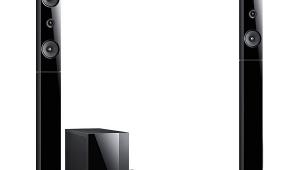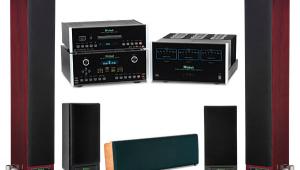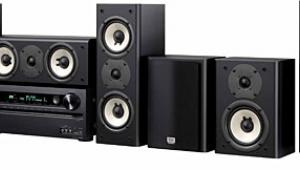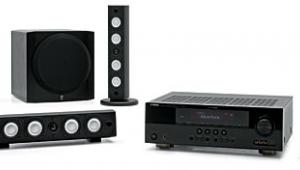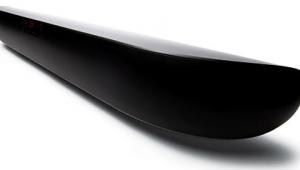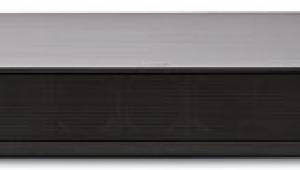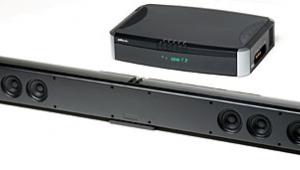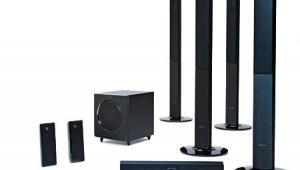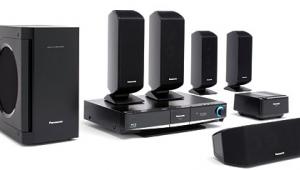Yamaha YHT-591 HTIB Page 2
 The remote is basic, old-fashioned, and does not include an LCD or any other fancy stuff. Still, the controls are well organized by color, background, and shape—I counted no fewer than seven different button shapes. Although the volume keys are larger than the rest, they could have been larger still, and I’d also add learning capability. But this remote is still better than one you’d get with a lot of pricier products.
The remote is basic, old-fashioned, and does not include an LCD or any other fancy stuff. Still, the controls are well organized by color, background, and shape—I counted no fewer than seven different button shapes. Although the volume keys are larger than the rest, they could have been larger still, and I’d also add learning capability. But this remote is still better than one you’d get with a lot of pricier products.
Here’s an important note about the onscreen graphic user interface. This receiver doesn’t have one. You have to squint at the front panel when you choose the settings. Of course, you can mitigate this shortcoming if you use the automatic setup mode.
I only used one piece of associated gear for this review—the Panasonic DMP-BD55 Blu-ray player. I used this for Blu-rays (all movie demos) and CDs (all music demos).
Comfort Food
To my surprise and pleasure, the system immediately established a high comfort level. Its sins were mostly those of omission. The top end was definitely rolled off, the midrange could be a little gauzy, and the sub’s dominant frequencies were eternally obvious. The crossover between the speakers’ 2.25-inch woofers (calling them woofers may be stretching the definition a little) and the sub’s 10-inch driver was also less than perfect. But while the system didn’t have a lot of sparkle or whomp, it did offer a polite top end, a midrange that was always warm and sometimes involving, and a soundfield of decent proportions, with no glaring timbre shifts among the five speakers.
Defiance uses Dolby TrueHD to tell the story of an ad hoc community of Jews who survive World War II in the harsh forests of what is now known as the Ukraine. The key sonic element is Joshua Bell, who adds eloquent solo violin to an orchestra that’s vague (a common characteristic of soundtrack recordings) but agreeably smooth and full. The timbre-matched speakers made it spread throughout the soundfield without collapsing. Voices could have resounded more in the outdoor setting—this lack of ambience may have been one of the few drawbacks of the reticent top end. Still, they were clear enough, especially since you can play the system consistently loud without ill effects.

Let the Right One In, in DTS-HD Master Audio, is a vampire story that kept me in suspense. Were these blood-lusting Swedes really vampires, or did they just think they were vampires as they launched themselves at their neighbors’ necks? The orchestral soundtrack, enhanced by solo guitar over the end credits, is practically a character in itself. It establishes a wistful humanity that offsets the story’s Nordic bleakness and troubled characters. The sub’s dominant frequencies could be a bit aggressive in musical peaks and even in small effects like a car driving away. I knocked the volume down from 40 percent of the maximum setting to 33 percent.
College Road Trip, in multichannel PCM, stars Martin Lawrence as a control-freak dad who drives his daughter to college-admission interviews with a menacing pet pig. The dynamics are limited, as they typically are in B-grade comedy. However, the music is well integrated and it sounded good, especially in the bus karaoke scene.
Boats, Punks, and the Perfect Marriage
While it’s not terribly detailed on the frequency spectrum, the system’s midrange is as comfortable as an old shoe. My musical demos didn’t induce a single moment of pain. In Guy Clark’s Boats to Build, mandolin and slide guitar solos came to the fore, while the remainder of the acoustic-guitar-centered arrangements were perhaps too defocused. The speakers emphasized the nasal quality of Clark’s voice, but they didn’t suppress his occasional rasp. At low volumes, the rhythm section had an acceptable balance. But at higher ones, the sub’s dominant frequencies were more audible. With all material, the system fared better in the Dolby Pro Logic II Music mode than in stereo—cutting down to two-channel collapsed the soundstage. Favorite lyric from “Picasso’s Mandolin”: “He’s born in Spain and died in France. He was not scared of baggy pants.”
The Peel Sessions Album by Gang of Four emphasized the system’s strong suit—its ability to make harsh material palatable. At this stage of their career, with their second album about to emerge, these punk pioneers went in for a hard electric edge and no frills. This BBC studio recording goes with the flow, with almost no reverb at the outset, although some creeps in later. The fabric-domed tweeters pleasantly sugar-coated Andy Gill’s vigorous electric guitar riffing and Hugo Burnham’s exuberant cymbal smashes. When Burnham launches into his awesome rolling drum part in “Guns Before Butter,” the sub kept up. However, this was after I raised the sub volume from one-third to just over one-half of its range.

By following the medical precept of “do no harm,” the Yamaha did a lot of good with my favorite recording of my favorite piano concerto—Brahms’ Piano Concerto No. 2, as performed by Rudolf Serkin, George Szell, and the Cleveland Orchestra. Simply put, I played it loud, and it didn’t hurt. If not exactly transparent, the presentation was certainly lucid, especially in the strings and the piano’s middle keys, where most of the melodies reside. Serkin and Szell are a perfect marriage of minds. I never had a sense that the piano soloist and conductor were egotistically pulling away from each other. This old CD still moves me.
With the YHT-591, Yamaha establishes a modest and reasonable set of goals and meets them well. The speaker enclosures and tweeters are of unexpectedly good quality. You get your money’s worth. In fact, you could spend the same amount of money and do far worse.

